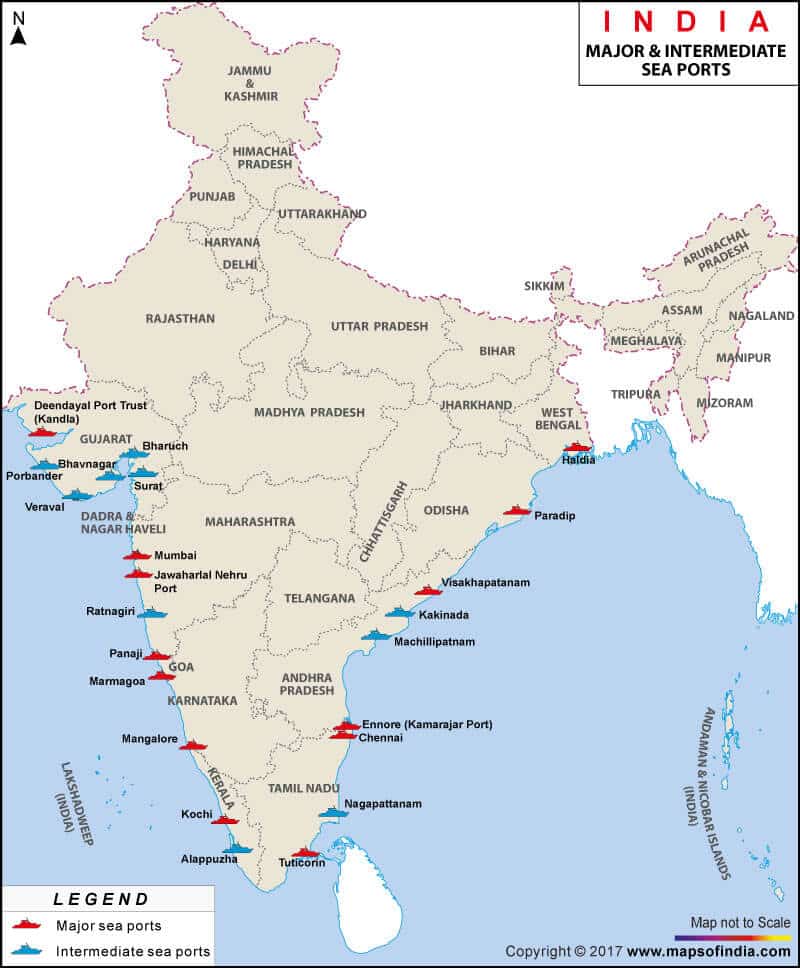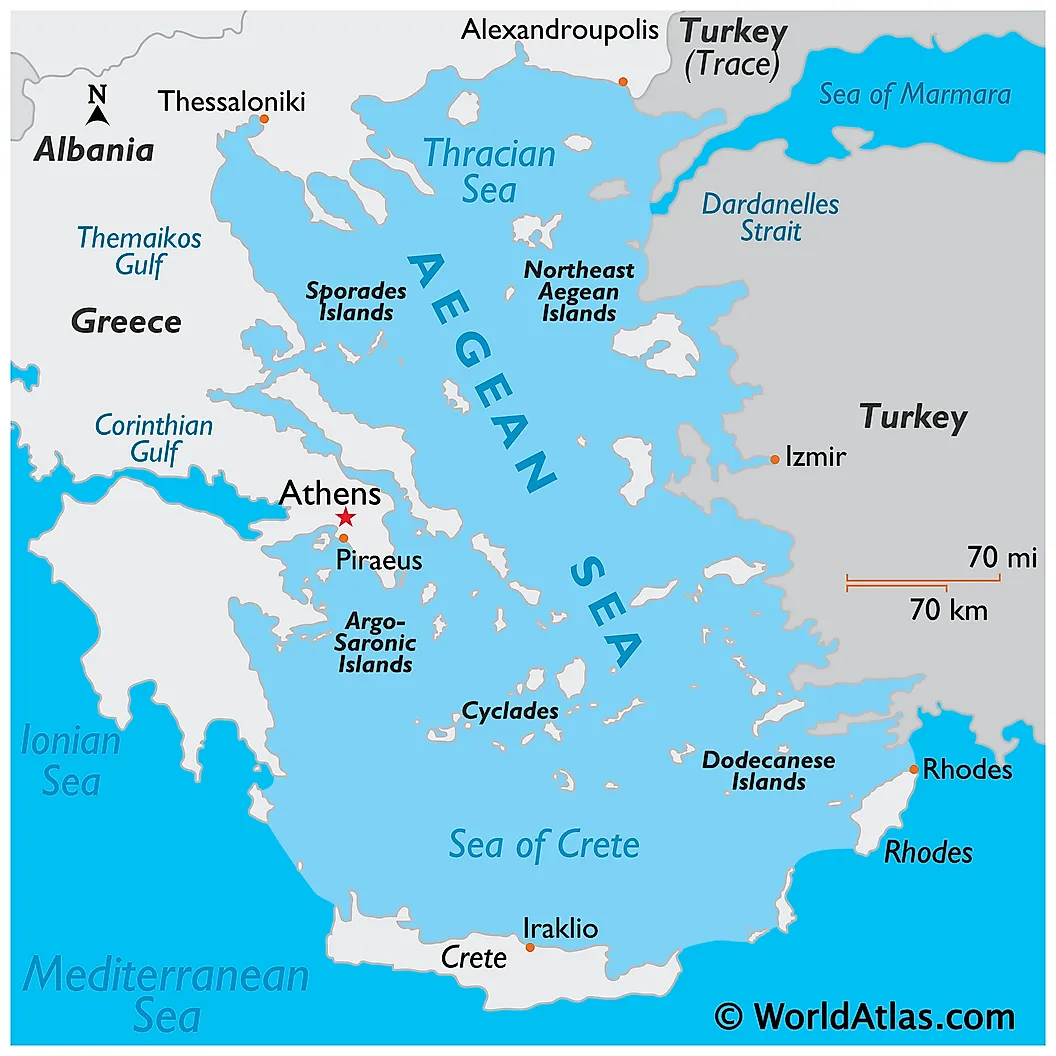- Home
- Prelims
- Mains
- Current Affairs
- Study Materials
- Test Series
June 22,2024 Current Affairs
Container Port Performance Index
- As many as nine ports of India have made it to the global top 100 rankings in the latest edition of Container Port Performance Index.
Container Port Performance Index:
- It is a highly regarded benchmark that assesses the performance of ports on parameters such as productivity, efficiency, and reliability.
- It is released by the World Bank and S&P Global Market Intelligence.
- It serves as a reference point for key stakeholders, including national governments, port authorities, development agencies, supra-national organisations, and private operators, in trade, logistics and supply chain services.
Highlights of CPPI 2023:
- Yangshan port in China and Salalah port in Oman emerged as the top two ports in the rankings.
- Nine Indian ports have secured places among the top 100 global ports.
- While Visakhapatnam Port made it to the top 20 ports of the world at 19 in 2023, Mundra Port also climbed up the index at 27 in the current ranking.
- This also marks an advancement from Visakhapatnam’s 115th rank and Mundra’s 48th position in the 2022 rankings.
- Vishakhapatnam Port has demonstrated impressive performance with a turnaround time (TRT) of 21.4 hours, achieving 27.5 moves per crane hour, and minimising berth idle time.
- Additionally, seven more Indian ports, secured ranks in the top 100: Pipavav (ranked 41), Kamarajar (47), Cochin (63), Hazira (68), Krishnapatnam (71), Chennai (80), and Jawaharlal Nehru JNPA (96).

|
Major ports in India Chennai Port, Kolkata Port, Haldia Port (West Bengal), Jawaharlal Nehru Port (Maharashtra), Kamarajar Port or Ennore Port (Chennai), Kandla Port (Gujarat), Kochin Port (Kerala), New Mangalore Port (Karnataka), Mormugao Port (Goa), Mumbai Port, Paradip Port (Odisha), Tuticorin Port (Tamil Nadu), Visakhapatnam Port (Andhra Pradesh). |
Ancient Greek sanctuary slowly sinks into the Aegean Sea.
- Recently,Scientists warned that due to climate change-induced rising sea levels, Delos, a small island in the Aegean Sea near bustling Mykonos, could disappear within the next 50 years.
Impact of Rising Sea Level on Delos Island
- Studies suggest that higher temperatures and humidity can change the chemical makeup of materials found in cultural heritage monuments.
- This risk is amplified by evident structural deterioration caused by seawater erosion, notably impacting structures such as trade and storage buildings dating back to the first and second centuries BCE.
Delos Island:
- Delos, situated in the Aegean Sea as part of the Cyclades archipelago, is a rocky island. It was initially inhabited in the 3rd millennium B.C. and gained prominence in the 1st millennium B.C.
- Today, Delos remains mostly uninhabited, featuring rugged granite terrain that spans approximately 1.3 square miles.
- History: Delos was revered as a holy sanctuary for a thousand years before being recognised as the birthplace of Apollo and Artemis in Olympian Greek mythology. The island’s Sacred Harbour includes three conical mounds linked to a goddess, Athena.
- UNESCO designated Delos as a World Heritage Site for its outstanding archaeological remains, significant influence on Greek architecture, and its sacred importance in Ancient Greece.
- Archaeological Importance: Extensive excavations have unearthed artefacts now exhibited at the Archaeological Museum of Delos and the National Archaeological Museum of Athens.
- The island has been inhabited since the third millennium BCE and functioned as a significant cult center for deities such as Dionysus and Leto.
- Delos underwent purification rituals to ensure the proper veneration of gods, which included relocating graves that were visible from the temple.

Aegean Sea:
- Delos is situated in the Eastern Mediterranean Basin, bordered by the Greek peninsula to the west and Anatolia (the Asian side of Turkey) to the east.
- Straits: The Bosphorus and Dardanelles Straits connect the Aegean Sea to the Black Sea and the Marmara Sea.
- Ownership of Aegean Islands: Most of the Aegean Islands are part of Greece. Turkey’s notable possessions in the Aegean Sea include Imbros (Gökçeada) and Tenedos (Bozcaada), located in the northeastern part of the sea.
- Climate: It features a Mediterranean climate similar to that of Western Turkey and Greece. The climate is classified as Hot-summer Mediterranean, with dry and hot summers and wetter, milder winters. Summers in the region are cooler compared to arid and semi-arid climates.
- The northern part of the Aegean Sea experiences a cold, semi-arid climate characterized by cooler summers.
- The weather in the Aegean basin is predominantly influenced by the Etesian wind.
Recently, the Union government notified the Public Examinations (Prevention of Unfair Means) Bill, 2024, effective June 21, 2024.
Background Of Public Examinations Bill 2024:
- The NEET-UG 2024 exam faced allegations of question paper leaks, and grace marks were awarded to over 1,500 students.
- Data Estimates: Estimates indicate that over 70 cases of question paper leaks occurred in the country between 2016 and 2023, affecting more than 1.5 crore students.
- Data shows that at least 12 recruitment drives in Rajasthan were cancelled between 2018 and February 2023 due to paper leaks.
Key Provisions of the Public Examinations Bill 2024:
- It aims to prevent the use of “unfair means” in public examinations and bring “greater transparency, fairness and credibility”.
- Definition of Public Examinations: Public Examinations refer to any examination conducted by a public examination authority listed in the Schedule of the Public Examinations Bill or any other authority that may be notified by the Central Government.
- The Schedule includes the Union Public Service Commission (UPSC), Staff Selection Commission (SSC), Railway Recruitment Boards (RRBs), Institute of Banking Personnel Selection (IBPS), and National Testing Agency (NTA).
- Exclusion of Candidates: Bona fide candidates of public examinations are excluded from the scope of the Act. Defaulting candidates will not be punished under this Act; instead, appropriate action will be taken by the respective public examination authority.
- Broad Definition of Unfair Means: The Act defines 15 actions that constitute the use of unfair means in public examinations “for monetary or wrongful gain.”
- These include leaking question papers or answer keys, directly or indirectly assisting candidates, willfully violating norms or standards, tampering with computer networks or resources, creating fake websites, and more.
- Cognisable Offence: Section 9 of the Act stipulates that all offences are cognisable, non-bailable, and non-compoundable.
- Consequently, arrests can be made without a warrant, and bail is not granted as a matter of right.
- Instead, a magistrate will decide if the accused is eligible for release on bail.
- Organised Crime: Section 11 of the Act pertains to organised crime, prescribing penalties of 5 to 10 years of imprisonment and fines up to 1 crore rupees.
- If any institution is involved in committing an organised crime, its property will be liable to attachment and forfeiture by the government.
- Punishment for Violations: Imprisonment for three to five years and a fine of up to Rs 10 lakh. If the convict fails to pay the fine, additional imprisonment will be imposed according to the provisions of the Bharatiya Nyaya Sanhita, 2023.
- Those involved in conducting the examination can be fined up to Rs 1 crore, along with other penalties.
- Investigating Authority: The Act authorises the Central Government to refer any case under its jurisdiction to a Central Investigating Agency as needed to ensure the matters are handled swiftly and with due diligence.
- National Technical Committee on Public Examinations: The bill proposes establishing a high-level committee to enhance the security of the computerised examination process.
- This committee will be responsible for developing protocols to protect digital platforms, creating robust IT security systems, ensuring electronic surveillance of examination centers and setting national standards for IT and physical infrastructure used in conducting examinations.
- Designation of a Public Servant: The Act designates officials of the public examination authority as public servants to ensure accountability and transparency in the process.
- Consequently, appropriate administrative action can be taken against any defaulting public servants in accordance with the authority’s service rules and procedures.
Need for Law to Prevent Unfair Means in Public Examinations:
- Lack of Substantive Law: No specific substantive law currently addresses unfair practices or offenses by entities conducting public examinations for the central government and its agencies.
- Existence of Unfair Practices: Malpractices in public examinations lead to delays and cancellations, negatively impacting the prospects of millions of youth.
- Ensuring Transparency, Fairness, and Credibility: The Public Examinations Bill aims to enhance transparency, fairness, and credibility in the examination system, ensuring that students’ genuine efforts are fairly rewarded.
National Forensic Infrastructure Enhancement Scheme (NFIES)
- In a bid to have more scientific investigations across the country to achieve better conviction rates in criminal cases, the Union Cabinet recently approved the National Forensic Infrastructure Enhancement Scheme (NFIES).
National Forensic Infrastructure Enhancement Scheme (NFIES):
- It is a Central Sector Scheme with a financial outlay of Rs 2,254.43 crore during the period from 2024-25 to 2028-29.
- It aims to enhance forensic infrastructure in the country.
Components under this Scheme:
- Establishment of campuses of the National Forensic Sciences University (NFSU) in the country.
- Establishment of Central Forensic Science Laboratories (CFSLs) in the country.
- Enhancement of existing infrastructure of the Delhi Campus of the NFSU.
- The financial outlay of the NFIES will be provisioned by the Ministry of Home Affairs from its own budget.
Need for NFIES:
- With the enactment of the New Criminal Laws, which mandates forensic investigation for offences involving punishment of 7 years or more, a significant increase in the workload of forensic science laboratories is expected.
- Further, there is a significant shortage of trained forensic manpower in the Forensic Science Laboratories (FSL) in the country.
- The establishment of additional off-campuses of the NFSU and new CFSLs would address the shortage of trained forensic manpower, alleviate the case load / pendency of forensic laboratories, and align with the Government of India''s goal of securing a high conviction rate of more than 90%.
New research found that Australia’s enigmatic pink sand- Garnet was born in Antarctic mountains.
Garnet:
- It is rare in beach sand which is destroyed by prolonged exposure to the waves and currents of the ocean.
- It is a fairly common mineral, deep red in color. It crystallizes at high temperatures, usually where large mountain belts grind upwards out of colliding tectonic plates.
- These are opaque, transparent to translucent minerals that can be found as individual crystals, pebbles, or clumps of inter-grown crystals.
- There are six main types of garnet, all with slightly different chemical compositions. All kinds of garnet can form in the same place and sometimes garnets can be a combination of types e.g. pyrope-almadine or pyrope-spessartine.
Formation:
- These are formed in metamorphic (schist, amphibolite, and eclogite) and igneous (some granites and peridotite) rocks.
- This mineral grows deep in Earth’s crust, in the same kind of conditions in which diamonds are formed.
- When sand contains an abundance of garnets, it usually contains epidote and magnetite as well.
- Australia produces almost half of the world''s garnets, with the rest mainly coming from India, USA, and China.
- Uses: It is used for manufacturing blasting media, abrasives, grinding wheels, mosaic cutting stones, decorative wall plasters, ceramics, polishing of picture tubes, glass polishing and antiskid surface for roads, air strips etc.









 Latest News
Latest News
 General Studies
General Studies